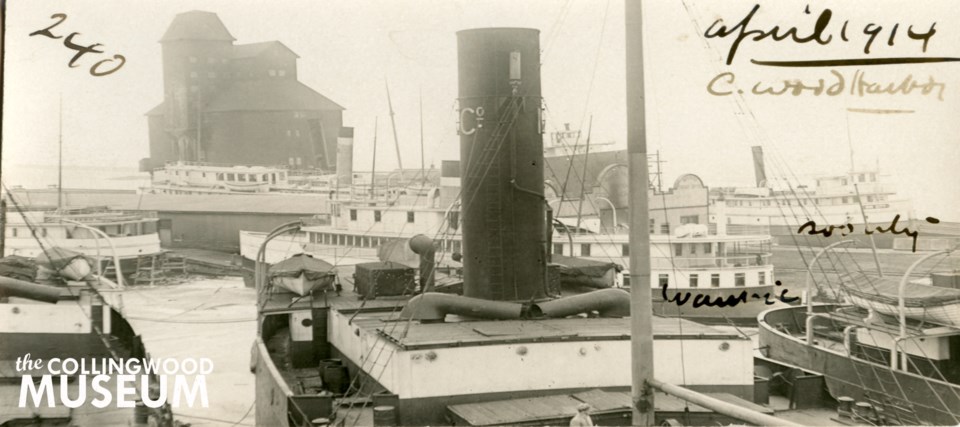This ongoing series showcases historic photos in the Collingwood Museum collection, with research and writing by Melissa Shaw, the museum supervisor.
The traffic on local roads and highways this Victoria Day Weekend may be the closest reference point to the once-busy days of Collingwood’s harbour that today’s residents experience.
When this photograph was taken in April, 1914, the ships’ various owners would have been eagerly awaiting the beginning of the 1914 shipping season. Likewise, the local men and women employed to work aboard the ships would have been equally excited to begin earning their wages.
At least eight ships are pictured in this photograph from nearly 110 years ago. The sections of three ships are visible in the foreground; an additional two are docked in front of the Grand Truck Railway’s freight shed in the photograph’s centre; and three more are visible lining the dock between the freight shed and the wooden grain elevator. This latter building stands in the background, preceding today’s Collingwood Terminals elevator by 15 years.
Constructed in the 1870s, this early wooden grain elevator warranted a mention in the 1915 Canadian Almanac. In the section devoted to grain elevators in Canada, Collingwood gets a significant nod in the opening sentences: “There was a public elevator at Collingwood, Ontario, at least as early as 1871; and from 1873 to 1885, when under the Treaty of Washington of 1871, and its protocols of 1873, Canadian vessels on the Great Lakes had conditional privileges in the coastwise trade of the United States – privileges confined to inland waters – grain was transported from Chicago and other American lake ports to Collingwood, thence by rail to Toronto and from Toronto was carried in Canadian vessels to Oswego and Ogdensburg.”
Just two of the ships in the photograph were identified by someone with a keen eye or memory. The nameplate for Soo City is just visible above the black ink recording its name. The Waubic is only identifiable by the label in ink.
Soo City was constructed as Mabel Bradshaw in 1889 in Benton Harbor, Michigan. After passing ownership between four American owners, the ship was brought to Collingwood by Captain Herbert Cleland in 1906. Cleland renamed the ship Soo City and it would continue to operate under this name until being repurposed in 1918 as a hunting lodge or clubhouse by its next owner. The earliest records at the Collingwood Museum record the machinery from Soo City was repurposed for use in a tug.
Hull 23, Waubic, was constructed in Collingwood in 1909 for short service on Georgian Bay between Penetang, Midland, Parry Sound, and Point au Baril. The vessel continued service on Georgian Bay until being sold to Rockport Navigation for excursion trade in the Thousand Islands. Waubic went on to have other owners and names, including “Erie Isle” and “Prince Nova”. The vessel was eventually damaged by a large waterfront fire in Pictou, Nova Scotia, in 1959 and its hull is presumed to have been scrapped.
Today’s featured photograph was collected, catalogued, and cared for by the Collingwood Museum’s predecessor, the Huron Institute. If you have any information to share about the content of this article, please contact Collingwood Museum staff.



